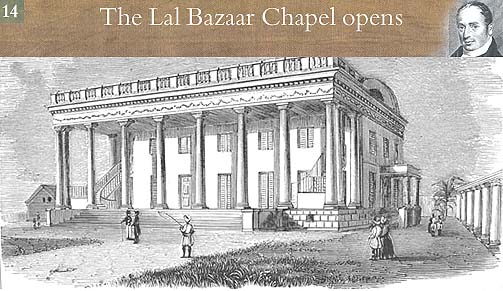

The Lal Bazaar Chapel. Courtesy ''The Centre for the Study of the Life and Work of William Carey D.D., 1761 - 1834.'
The rupture between the courts of England and Denmark in September,1807, was followed by the occupation of Serampore. On the morning of 4th January, 1808, 3 companies of Sepoys crossed the river from Barrackpore, and the commander demanded the surrender of the town and factory. The request was complied with as a matter of course. All the Danish vessels lying off the town or in the river, 12 in number, together with the valuable merchandise collected in the warehouses of Serampore, served to enrich the captors. It was subsequently returned to Denmark after the termination of the war with Denmark, in 1815, but the Danish East India Company never recovered from the blow.
The friendly Government of Denmark had now lost the power of affording the missionaries protection, and they were at the mercy of those who, not 6 months before, had determined to break up their Press and establishment. Happily, Lord Minto had recovered from the 'Vellore Mutiny'; he had, moreover, become personally acquainted with the character and views of the missionaries, and the disposition to interfere with their labours had subsided. On the establishment of the British authority in the town they were, therefore, allowed to pursue their work without hindrance.
'Conversions' writes Ward 'among the heathen are very rare; things in Calcutta very encouraging. Health, harmony, and some degree of activity among us. If God be pleased to pour out his spirit among the heathen, we shall go on in triumph, but the absence of this makes everything unsatisfactory.' But they were cheered by the success which attended their labours among the Armenian and Portuguese in Calcutta. Their private room in Cozitollah (1) was thronged with hearers, and the erection of the chapel in Bow Bazaar was pushed forward with redoubled vigour.
Every effort was made to promote the spirit of co-operation, and many concessions were admitted, but with very little permanent effect. It was scarcely reasonable to expect 10 men, with great diversities of temper, the greater number of whom were married, would be able to act together without discord. The control necessarily exercised by the 3 senior missionaries was unpalatable to their Junior Brethren.
To put an end to these contentions, which formed a more serious obstruction to progress than ever the hostility of Government, Carey and his 2 colleagues had proposed that the management of the Mission should be vested in a body chosen by a majority of the missionaries. Andrew Fuller, the Secretary of the Baptist Missionary Society, peremptorily refused to ratify this. To entrust the welfare of the Mission to a body of electors whose inexperience and passions, but for the wisdom and firmness of the 3 Senior Brethren, would long since have broken up the establishment.
Controlling authority was delegated to Carey, Marshman and Ward, for their lives, and they resolved to act with more decision in the government of the Mission. The junior missionaries were offended at the stringency of the rules regarding the strict economy, the severe restrictions on individual freedom, and the great sacrifice of social and domestic comfort which the life at the Mission involved. Carey and his senior colleagues had fallen into the error of creating a Moravian system that demanded self-denial, without conceding Moravian equality. They did not perceive that the individual enthusiasm, which could alone sustain such self-denial, was destroyed by the principle of obedience to superior authority.
Later, in 1811, there were 8 missionaries on the roll of the Mission, excluding Carey, Marshman and Ward. One half of the 8 ought never to have embarked in labours to which they were totally unsuited. In reference to one of them Ward writes:
'He translates in none of the languages; he has attempted no language but the Bengalee, and in this, I fear, he will never be worth a straw. He makes one blush every time he endeavours to speak in this language, and as to his hearers profiting by this jargon, it is out of the question.' Of two of them Carey writes in the same year 'They will do nothing, and can do nothing.'
In a letter to Fuller, Ward writes:
'In our work, half the Dissenting ministers in England, who merely preach twice or thrice a week, when people come to hear the Word, would be of little use. A man who shall do good here, must be on his legs, or in the saddle, or in his boat. In the hands of a mere domesticated man, who prays at home, but never goes out into the highways and ditches, things die a natural death. Men must go out a fishing; the fish will never leave their natural element and walk into their nets, and they must be patient too, though they toil all night and catch nothing.'
On 1st January, 1809, the desire for a chapel in Calcutta for the English and native congregations was accomplished. The chapel in Bow Bazaar was opened by Carey on that day. It was a spacious, lofty, and elegant edifice, with a gallery on 3 sides, and a noble portico at the front entrance. It was the third Protestant, and the first Dissenting chapel in Calcutta.
Three months after the chapel had been opened the English congregation increased to 200.
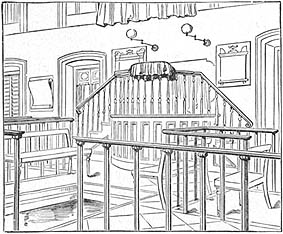
Interior of Lal Bazaar Chapel, Calcutta. Courtesy 'The Centre for the Study of the Life and Work of William Carey D.D., 1761 - 1834.'
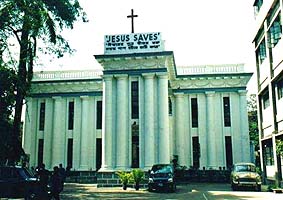
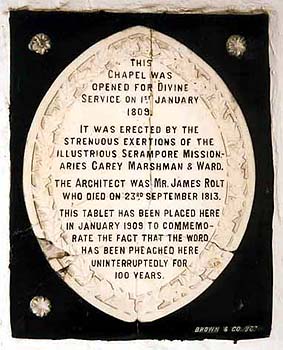
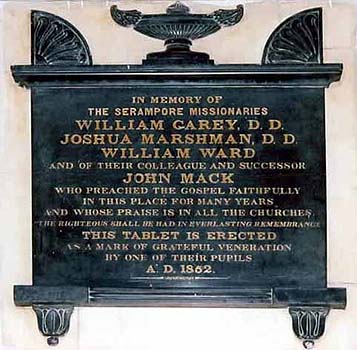
Top: Carey Baptist Church, Bow Bazaar. The basic structure of the original building can still be seen. Bottom left and right: plaques inside Carey Baptist Church. All three pictures taken in February 2003 and reproduced with the kind permission of Rev. Peter Shepherd, Broadway Baptist Church, Derby.
(1) This possibly refers to the room in the Chitpore Road.